Stretching approximately 30 miles long and 10 miles wide, the Indiana limestone belt can be found along the green pastures of Indiana. The limestone quarried from areas of this narrow band, which was discovered in 1827 and runs through Owen, Monroe and Lawrence counties, is recognized on many notable architectural landmarks and prominent buildings across the country, including the Empire State Building in New York City; the National Cathedral and Pentagon in Washington, DC, and more recently, the new Yankees Stadium in The Bronx, NY. The material was also extensively used to reconstruct buildings that were lost in the Great Chicago Fire of 1871.
Recently, Stone World had the opportunity to tour this region, which remains a viable source of limestone. The quarries and mills that we visited were busy with activity – many working on multiple projects, including some high-profile ones. Each company that we stopped at along our route was welcoming and had their own story to tell. While some are small operations still only relying on planers and Old World handcraftsmanship to create their products, others operate on a larger scale and combine artisan skills with modern technology. No matter what the size or method of production, there is one shared common denominator among all of the stone producers and fabricators – a passion for carving Indiana limestone and continuing its reputation as a premium, sustainable, building material.
This trip was made possible by Todd Schnatzmeyer of the Indiana Limestone Institute, whose well-thought-out itinerary allowed us to make the most of each day and visit as many companies as possible in our two-day time period. All of the companies that we visited are members of the Indiana Limestone Institute, whose mission is “to ensure continued and relevant promotion, education and direct support in the design, application and care of Indiana limestone through proven reference, research and technical data, resulting in projects of enduring beauty.”
The following pages will provide a brief overview of only a portion of the quarries and mills that are devotedly producing Indiana limestone products for projects all over North America. Currently, there are a total of
nine active stone quarries and 20 fabricators in the region and another 33 fabricators across North America.
Ionic Cut Stone Inc.
Master Stone Carver Franklin Bault has been sculpting limestone for almost 50 years. The owner of Ionic Cut Stone Inc. in Spencer, IN, began honing his craft at the early age of 13. “Indiana limestone is the best to use,” he said. “My dad was a big inspiration. He’s the reason I started. Carving is at the top of the food chain. You want to be the best you can. The industry has helped us a lot.”
Bault and his wife, Deborah, have owned and managed the stone carving business, since Bault’s parents, Paul and Jessie, retired in 2005. The company was founded in 1994 and has always specialized in custom hand-carved Indiana limestone work by master carvers.
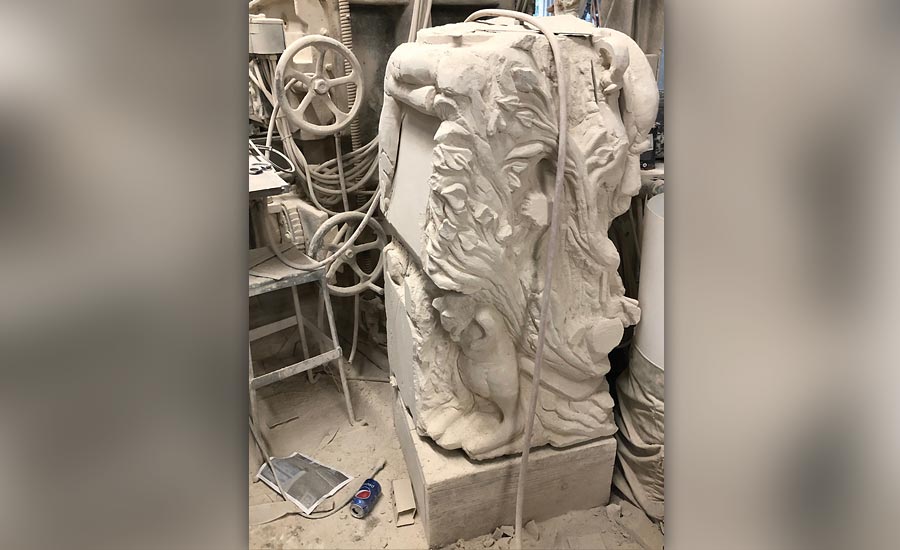
When establishing Ionic Cut Stone, Paul Bault decided on the name Ionic because he believed that the beautiful Ionic capstone form is symbolic of the beauty that lies within each piece of Indiana limestone.
Ionic Cut Stone fieldwork restoration specialty is repair of Indiana limestone using “Dutchman repair” techniques, which uses stone replacement instead of artificial fillers. Bault is an authorized Jahn installer using Jahn Restoration mortars since 1997. Additionally, Bault is an expert Bonstone installer — another form of limestone repair.
At the time of Stone World’s visit, Bault and his team had recently finished carving pieces for a restoration project on the Tribune Building in Chicago, IL, and they were working on a job for the Marriott Hotel in Indianapolis which required removing the terra-cotta pieces and replacing them with Indiana limestone.
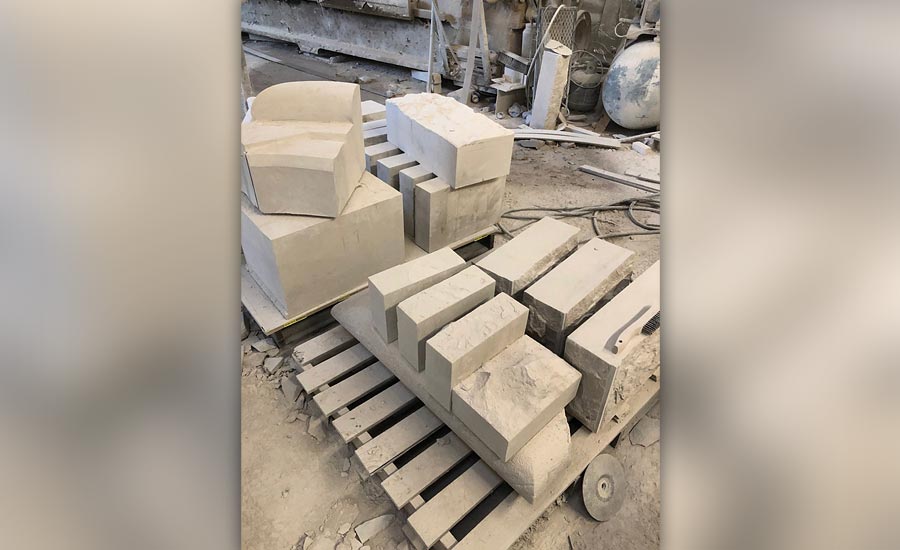
At the present time, Bault has a staff of five workers at Ionic Cut Stone. The master carver travels to any jobsite nationwide to create restoration pieces to replace damaged limestone, or to replicate original limestone designs when historical sites add to their existing structure and wish to preserve the uniformity of the original limestone carving work.
Indiana Limestone Fabricators (I.L.F.)
Indiana Limestone Fabricators first opened its doors in 1995. The Spencer, IN-based company was founded by Brad and Michele Mobley, and combines skilled craftsmanship with modern machinery to service the architectural community.
Brad Mobley explained that through his experiences of working for large companies he recognizes the specialized needs of contractors and owners of small- to mid-sized projects that large companies working on bigger jobs often neglect. Mobley and his staff are there to assist architects who have minimal experience of working with stone, as well as those that are familiar with stone and want to achieve a specific aesthetic that’s within their budget. “When I get architects here, it is fun to put an air tool in their hand,” said Mobley.
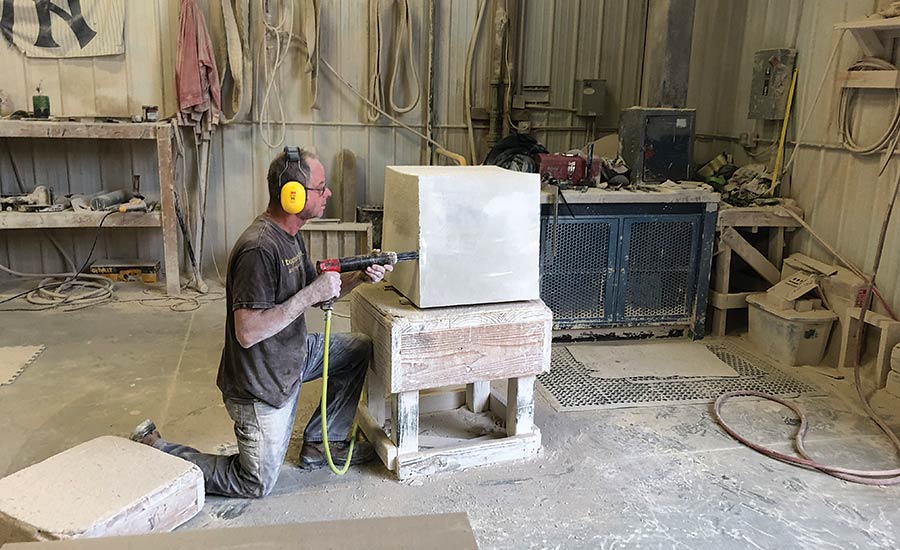
In addition to air tools, Indiana Limestone Fabricators has three Northwood CNC stoneworking centers, several Wilson Industrial saws and equipment from Park Industries. “We bought the first CNC in 2006,” said Mobley. “We learned a lot about CNC before approaching Northwood Machine and requesting them to modify their machine for dimensional stone fabrication. Their machine has fulfilled our expectations.
“It’s really reinvented the industry,” Mobley went on to say. “It’s allowed us to be much more competitive. We can compete with simulated stone and larger companies.”
While technology has assisted in increasing production capacity, Mobley still believes in handcraftsmanship as well. “I’m still convinced that the traditional lathes are better for making balusters, and modernized drives on the planers keep these machines performing at a high level,” he said.
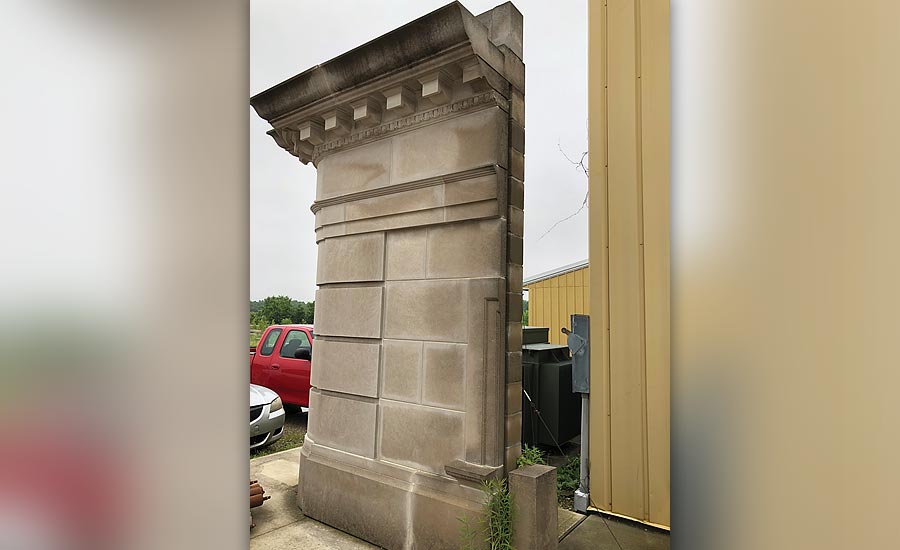
The company has completed work for many high-profile projects, such as limestone-faced pre-cast panels for the new Yankee Stadium (80,000 square feet) and the 888 Madison Avenue building for Ralph Lauren in New York and the U.S. Embassy Canberra in Australia, as well as at Yale University, to name a few.
For the Ralph Lauren project, Mobley explained that the design team came out to the mill to view a mock-up, which still stands outside Indiana Limestone Fabricators’ facility today (pictured). “It was a cool learning process for everyone involved,” said Mobley. It’s so important for architects to see the process.” Indiana Limestone Fabricators is a Veteran Owned Business Enterprise.
Big Creek Limestone
Established in early 2003, Big Creek Limestone is a family owned business that sits on 350 acres of quarry land in the Stinesville District of the Indiana Limestone Belt. The district is known for being the first primary commercial limestone quarry and fabrication center for the Indiana limestone industry.
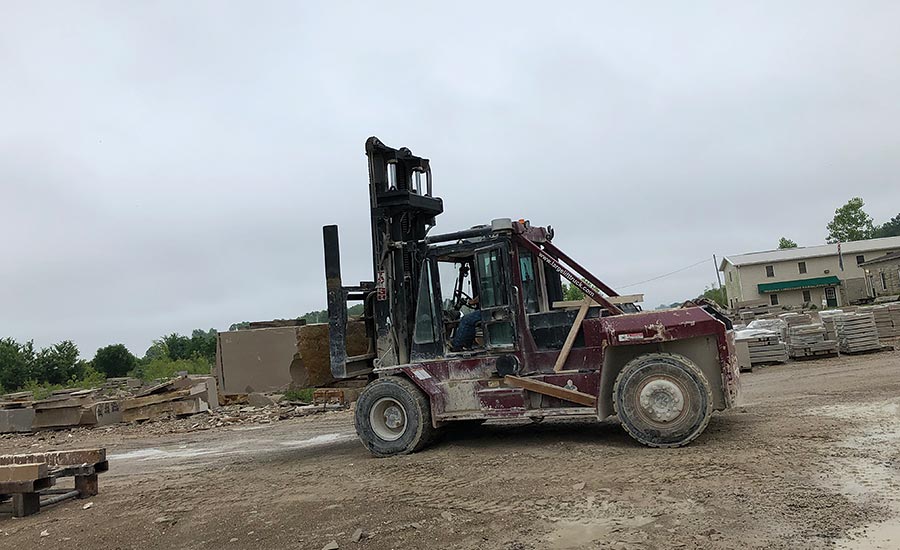
According to the company, based on an inspection of the property and a review of reports from the State Geologist of Indiana in the early 1900s, the Big Creek property was first quarried in the 1850s along Big Creek. Prior to the reopening in 2003, it appears that the last active quarrying on the property was in the late 1940s or early 1950s.
Big Creek Limestone was created by members of the Edgeworth family, including Terry Edgeworth, Mike Edgeworth, Maggie Edgeworth Randall and David Edgeworth, after selling their interest in a previous limestone venture. The family members are third and fourth generation Indiana limestone quarry operators.
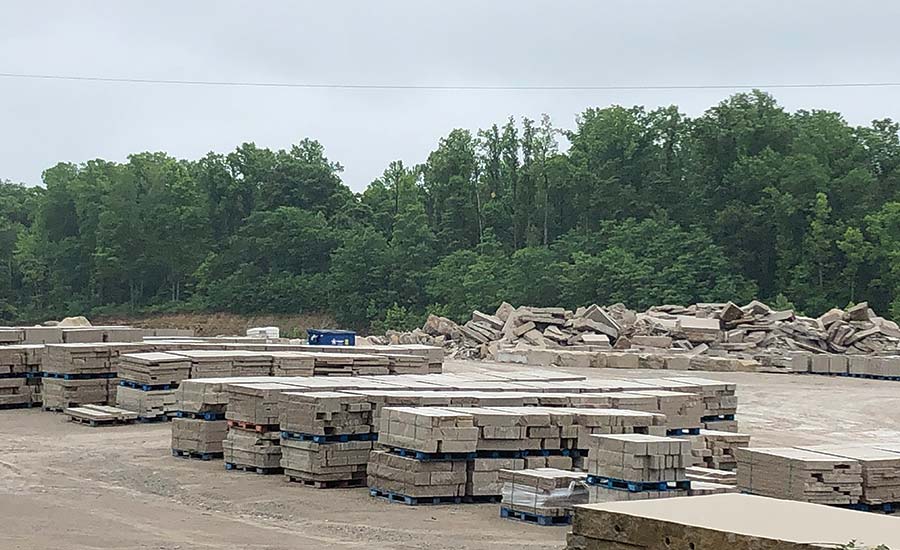
Big Creek Limestone’s quarry yields only buff colored limestone. The company’s integrated mill produces a wide variety of veneer, trim, custom and landscape products.
Bybee Stone Co.
Operating out of a 50,000-square-foot facility in Ellettsville, IN, Bybee Stone Co. was founded by Wilbur C. Bybee in 1979. The company’s roots in limestone date back much farther, as Bybee’s grandfather, Henry Woolery, founded Woolery Stone Co. in 1913. After working for three decades at his grandfather’s mill, Bybee bought the Matthews Brothers Mill in Ellettsville, IN, in 1979 and renamed it Bybee Stone Co.
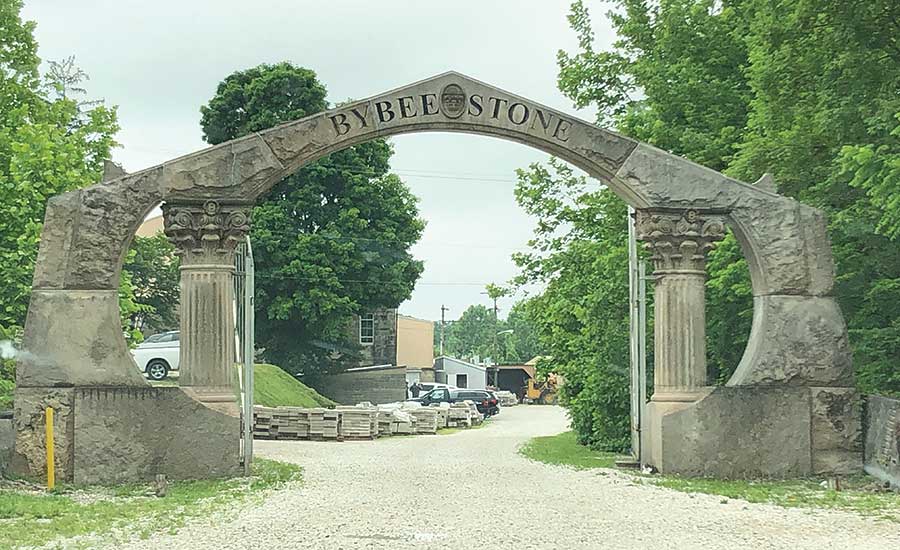
Will Bybee took the helm as the company’s president in December of 2000 and still is in this position today. According to Bybee Stone Company, its mission continues to include “staying abreast of technology while maintaining its ability to handle time-tested and antique finishes.” Moreover, sustainability and a sensitivity to its functional footprint are also a priority for the company.
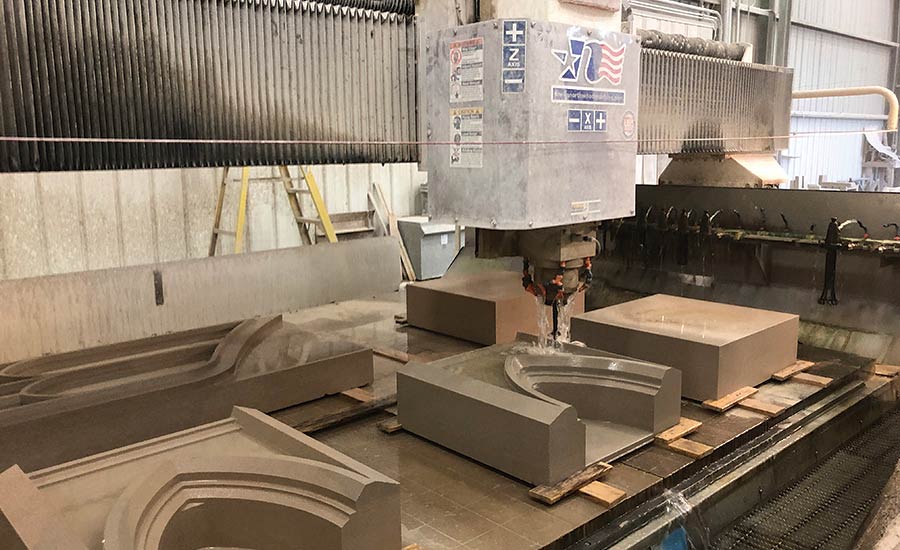
Keeping its philosophy in mind, Bybee Stone Co.’s facility is a combination of master stone carvers using their honed artisan skills and modern technology. The company remains one of the last mills to run gangsaws that cut the blocks into slabs. There are four in total which take about eight hours to cut through the blocks. It also has a vertical lathe that was custom made by Park Industries in the late 1980s, which is still in operation for certain projects (pictured on right). More recently, the company invested in a Northwood CNC stoneworking center, which runs 24 hours, seven days a week (pictured on bottom left). “It’s great with small details,” said Jeff Leisz, superintendent.
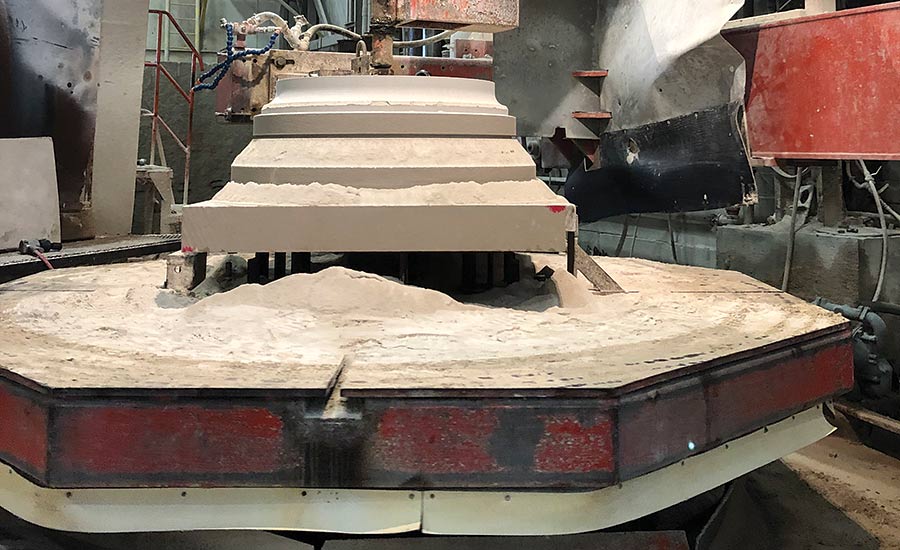
Bybee Stone Co. is experienced in custom new construction projects, as well as stone restoration work. At the time of Stone World’s visit, the company was fabricating pieces for the new Performing Arts Center at Belmont University in Tennessee. Additionally, it was providing new balustrades for a bridge that was being restored in Des Moines, IA.
Independent Limestone Co.
Producing Indiana limestone since 1927, Independent Limestone Co. of Bloomington, IN, is privately owned and prides itself on working towards running a sustainable operation. The quarrier is going through the ANSI/NSC-373 standard of certification by the Natural Stone Council, which demonstrates its commitment to the environment.
“We figured someday everyone is looking towards it so we should get out ahead of it and be done when others might start to get forced to do it,” said Brian Smith, superintendent, about the certification process. “The families that own Independent are good people and will do what it takes to keep the quarry running.”
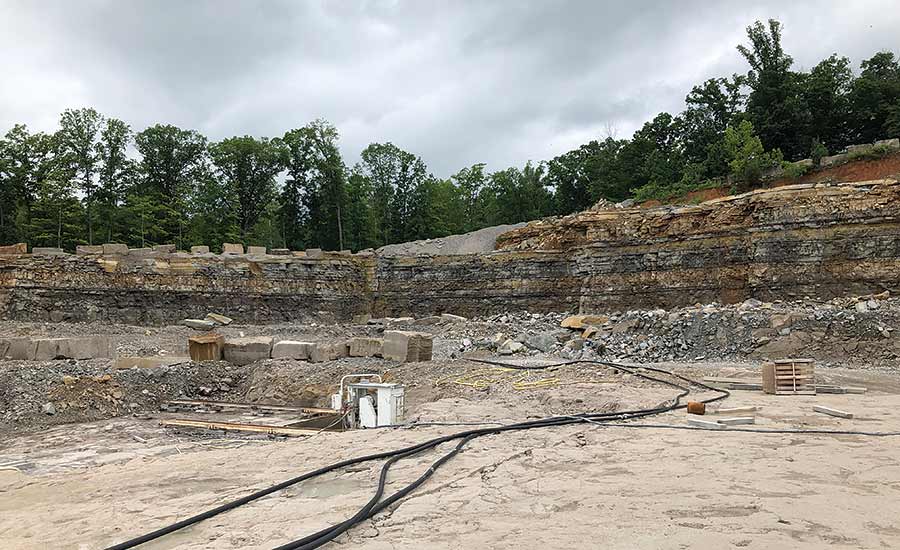
As one of the leading quarries in Indiana, Independent Limestone Co. has supplied its limestone products to many prestigious projects throughout the U.S., including Millennium Park in Chicago, the Washington Cathedral and the Pentagon Phoenix Project. “The renovation project for the Pentagon from the terrorist attack on 9/11/01 has been by far the most meaningful,” stated the company. “We are very proud to have provided limestone for this rebuilding project.”
The company’s property spans 600 acres and it has only used somewhere between 100 to 150 acres so far, according to Smith. A typical block size ranges between 80 to 100 cubic feet. The extracted limestone is sold as blocks, slabs and standard product.
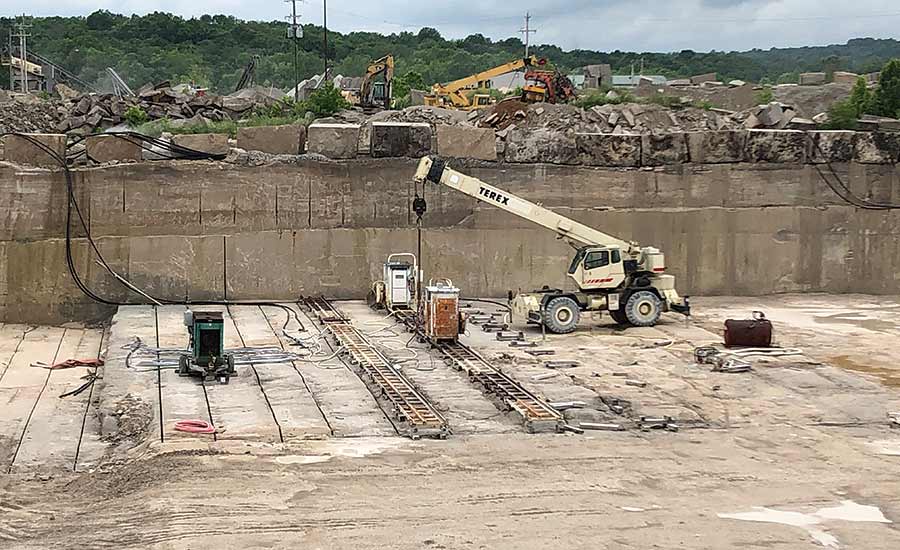
Independent also crushes stone, as a way to minimize its waste. Smith explained that the company invested in a new crusher two years ago. “It’s doing well for us,” he said. “About 30% of the stone located above the quarryable floors from which the company cuts blocks gets crushed. It’s the material that is not good for dimensional pieces.”
Beyond its quarries, Independent is an active and conscientious member of the Bloomington community. It is a long-time contributor to the Boys & Girls Club, the Salvation Army and a proud supporter of military families at the Fisher House Foundation.
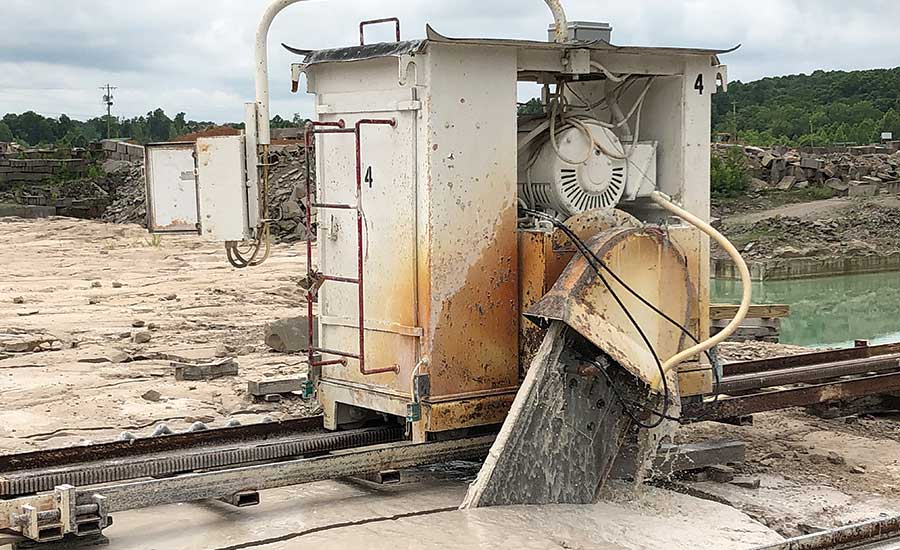
“We are grateful for our employees, their families, and our community who have all played such an important role in Independent’s place in history,” said Jane Nelson, the company’s vice president. “We recently celebrated our 90th anniversary and we look forward to the next 90 years.”
As a testament to the company, nearly half of the employees have been with Independent for 15 years or more, four of whom have reached the 30 plus year mark.
TexaCon Cut Stone, LLC
TexaCon Cut Stone, LLC was founded by two friends and industry professionals out of necessity. Joe Dellacroce of Connecticut Stone and Brenda Edwards of TexaStone Quarries could not be competitive in quoting and fabricating Indiana limestone. After searching for solutions for a year and a half, in 2013 they made the decision to purchase an old mill in Bloomington, IN, which had been dormant for five months. They soon partnered with Tevin Norman, who is also a co-owner, to run the day-to-day operation while they are away tending to each of their other businesses.
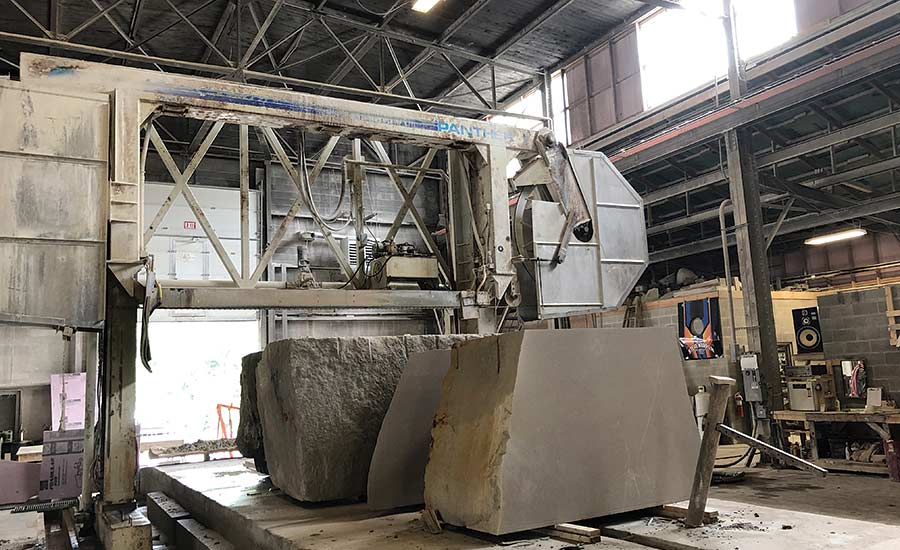
Prior to becoming TexaCon Cut Stone, the business was originally known as the Fluck Cut Stone Company. Initially based in Chicago, IL, the mill was dismantled and rebuilt in Monroe County, Indiana, in 1930. Norman explained the reasoning behind the move was that the original owners wanted to be closer to the quarries. The company purchases Indiana limestone blocks from various quarries in the Indiana Belt, which includes Monroe, Owen and Lawrence counties, for fabrication purposes.
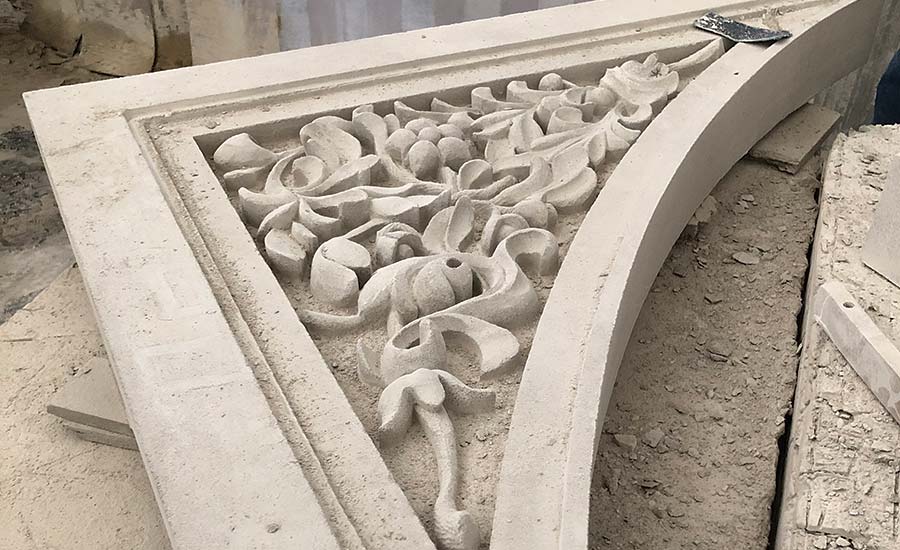
The original mill is 21,000 square feet and TexaCon Cut Stone finished the addition of a second 12,000-square-foot building in 2017. The company combines Old World craftsmanship with modern technology, which includes four CNC machines, to create high-quality products for projects nationwide. “It is nice that we can offer our customers both methods,” said Dellacroce.
TexaCon Cut Stone has grown tremendously since it opened its doors – growing from a staff of six to 40 people. “We have four carvers on staff, which is pretty good for a size company like ours,” said Norman.
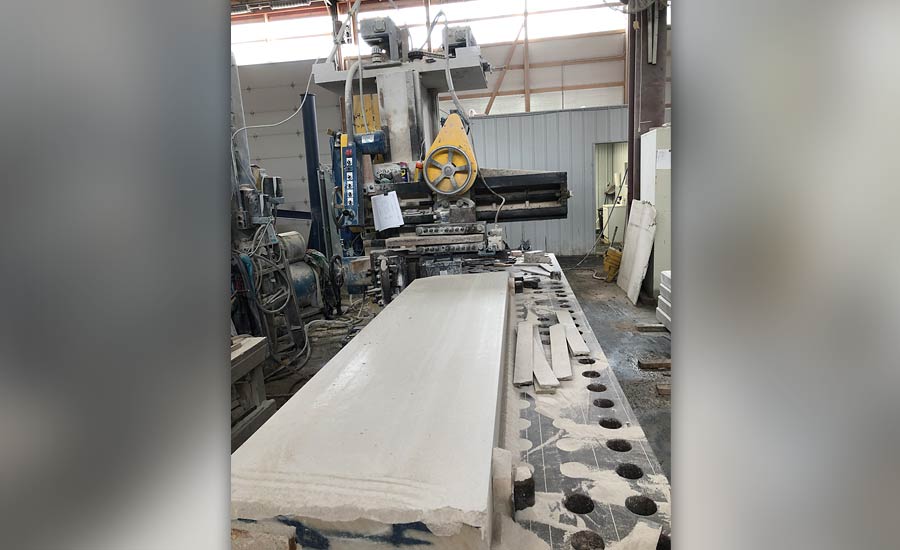
A significant portion of the company’s work is high-end residential projects in Canada, according to Norman, but it also does commercial jobs. At the time of Stone World’s visit, the mill had just finished cutting 60-plus truckloads of Indiana limestone for a courthouse project and it was also working on a New York City high-rise project. “The sky’s the limit,” said Edwards.
3D Stone Inc.
In four years, Lily and Kurt Sendek have taken a reputable architectural stone company and further enhanced its capabilities with investments in technology and fostering a family environment for its employees. 3D Stone Inc., based in Bloomington, IN, was established in 1992 by those with deep roots in the masonry trade who had a vision to build a company that would become a leader in the Indiana limestone product market. The Sendeks took ownership of the company in 2015 – keeping the momentum going with new CNC machines and custom software programs to ensure top-quality production and customer service. Moreover, 3D Stone Inc. was granted State of Indiana WBE status in 2017. Since then, 3D Stone is now certified as a Woman Owned Business for the City of Indianapolis, and as of September of 2018, the company has been awarded National WBE, as well as WOSB status certified by the WBENC.
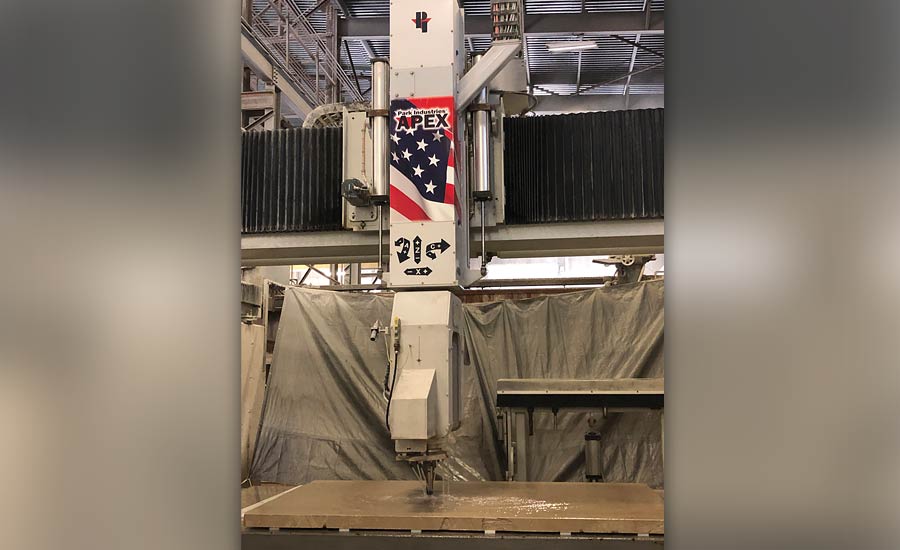
The 52,000-square-foot mill sits on 88 acres in Bloomington’s beautiful countryside. “We have room to spread out, and maybe one day expand,” said Lily Sendek.
When walking into the production area, the mix of new technology with century-old artisan techniques is evident. There are seven planers, as well as a custom-designed Apex 5-axis CNC stone-cutting machine that was installed in September of 2016 (pictured on left). The machine is the first of its kind to be produced by Park Industries of St. Cloud, MN, and produced a 20-percent increase in 3D Stone’s overall production throughout. It has allowed the company to cut more intricate pieces of stone at twice the speed of predecessor machines. “We see melding Old World techniques and the new world,” said Sendek.
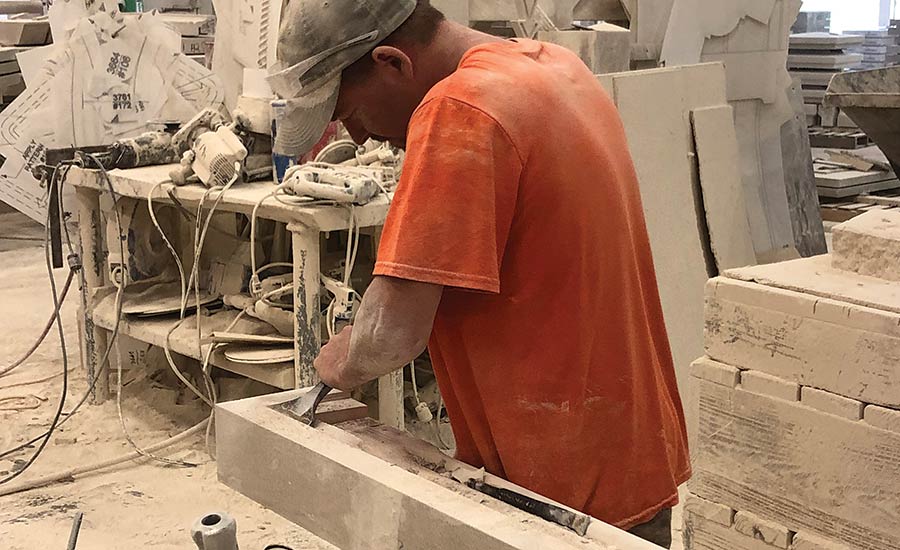
“We ticket and track every piece of stone that runs through the mill using our custom stone monitoring program with the use of barcodes and scanners,” Sendek went on to say. “The system prioritizes workload for the production team and lets everyone know what they should be working on. We have a large state-of-the-art facility that is very capable of huge jobs, as well as simple as a single fireplace. We want to continue to drive advancements in technology to maintain a competitive environment for our industry.”
3D Stone Inc. fabricates with the environment in mind. “We recycle all of our water,” explained Sendek. “The water flows to three different ponds. The building was totally renovated in 2008-2009, and we are looking into solar panels.”
Indian Creek Stone Products
Tom Kimmel started his company 36 years ago picking up fieldstone in his pick-up truck and selling landscape boulders. Since that time, he has grown Indian Creek Stone Products of Mitchell, IN, to a team of 40 employees that has become a viable source for Indiana sandstone and limestone products, including custom pieces and thin veneer.
“About 20 years ago we shifted to limestone cut stone,” said Kimmel. “It came about slowly because I didn’t have the funds. Fifteen years ago, we started doing thin veneer.”
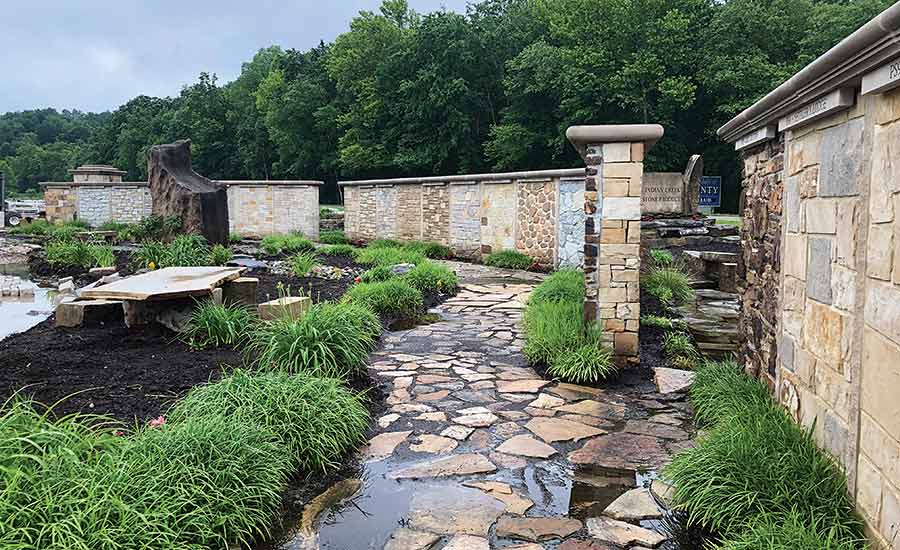
As the market continues to change, Kimmel explained that Indian Creek Stone Products recently completed an addition to its mill where it is mostly cutting standards. “We are seeing a need for that – especially in the design and architectural community.”
The mill is equipped with a 210-foot-long Superline saw, which makes 25 cuts at once. This machine is primarily utilized to cut standards.
With two of its own quarries – one for limestone and one for sandstone – the majority of the products sold by the company is its own, although it also does buy some limestone from other suppliers. The strategic location of its stone yard along a busy highway has also proven successful for Indian Creek Stone Products. A beautiful collection of display walls is eye-catching to those passing by.
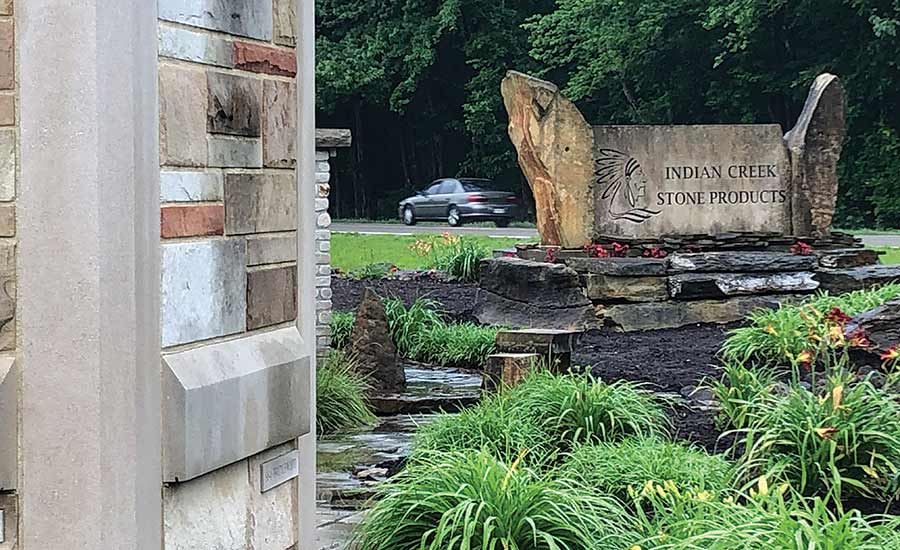
“We finished the display walls in 2008,” said Kimmel. “I had a feeling something was going to happen [with the economy] so I wanted to be prepared to let people know what we have. This saved us. The industry imploded, but the walls were impressive to people building big mansions and they bought from us. We were doing these huge houses – some as big as 30,000 square feet.”
Almost everything on the display walls is the company’s own material, and all of the varieties are sold as thin veneer, as well as cubic pieces. “Stone has always worked out for me,” said Kimmel. “Indiana limestone is unique because it doesn’t compete with anything.”
Kimmel went on to say that another advantage of the display walls is that they show the many color variations and patterns of the Indiana limestone and sandstone. “They are a 24-hour salesman,” he said, adding that his business is transitioning from dealing with contractors to distributors.
Architectural Stone Sales, Inc.
Launched in 1971, Architectural Stone Sales, Inc. of Bedford, IN – previously known as Bedford Cut Stone – is owned and operated by members of the Evans family. The business, which is in its fourth generation, produces custom cut stone pieces for projects across the U.S.
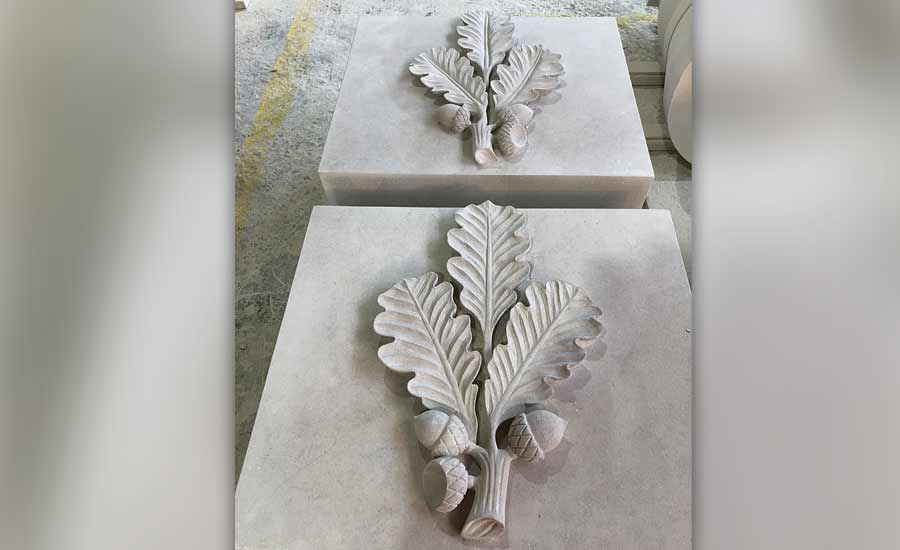
Currently, Architectural Stone Sales, Inc. employs a staff between 25 to 30 workers, which comprises skilled carvers, equipment operators, draftsmen and administrative personnel. Everyone works together to ensure a high degree of efficiency, quality and customer service.
Among the company’s most memorable projects is the rose window at the University of Denver, which was intricately cut from Indiana limestone. “There are 26 pieces inside and 26 pieces outside,” explained Curt Adams, general manager at Architectural Stone Sales. Another unique project Adams spoke of was the Indy cars carved from Indiana limestone blocks that were donated to the Indianapolis Motor Speedway Museum and displayed at the Indy 500 (pictured on bottom right).

At the time of Stone World’s visit, the mill was busy with activity. The carvers were working on detailed limestone pieces. Among recent projects were the Mandarin Oriental Boston, which Architectural Stone Sales provided 30 truckloads of limestone for the job. According to Adams, the company also produces a great amount of work for Washington University in St. Louis, MO, and it was working on the balustrades for a bridge in Kentucky.
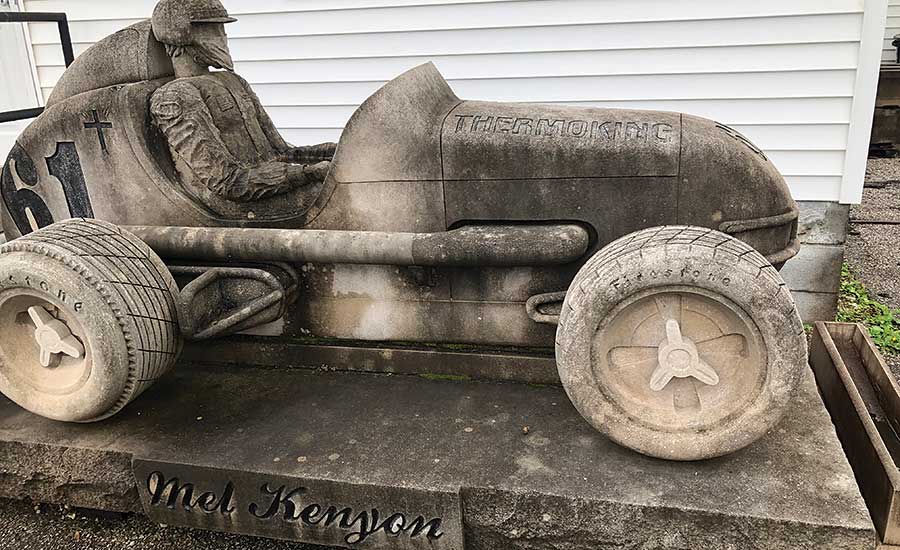
To ensure a safe and timely delivery of its stone products, the company also runs Architectural Stone Transport, LLC. The trucking company further demonstrates the Evans family commitment to quality products and customer service.
Elliott Stone Company, Inc.
Elliott Stone Company, Inc. offers a unique approach to extracting Indiana limestone, as the primary area of its quarry is underground. This not only permits the company to continue quarrying through the harsh winter months, but Elliott Stone Company believes this quarrying method will maintain their limestone supply for many more years. “Our reserves are estimated about 500 years at current production,” said Ralph Morgan, treasure of Elliott Stone Company. “Utilizing the underground technique could expand the belts supply for over a thousand years.
“The property has been quarried for well over 100 years,” Morgan went on to say. “We bought a large portion from Indiana Limestone Company in the 1970s and 1980s. The open space of the quarry is 50 acres, and there is farmland on top of the underground area.”
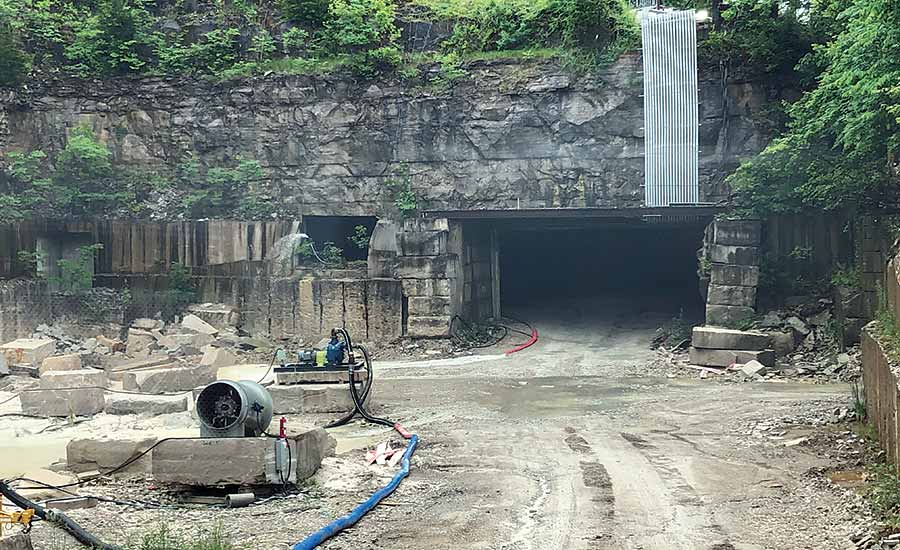
Morgan explained that the company began quarrying underground in 1988. “It is designed as a permanent structure,” he said. He went on to say how Elliott Stone Company has made five of its own saws, which they currently are running four (pictured on bottom right). It takes about a day-and-a-half to two days to cut a wall, and the saws are remotely watched using telemetry to monitor saw position and movement. The deepest part of the quarry measures 50 to 60 feet down.
In addition to traditional planers and stone carvers, Elliott Stone Company runs a Prussiani CNC machine. “When we first got the CNC, I thought we would get rid of the old planers, but we use both,” said Morgan.
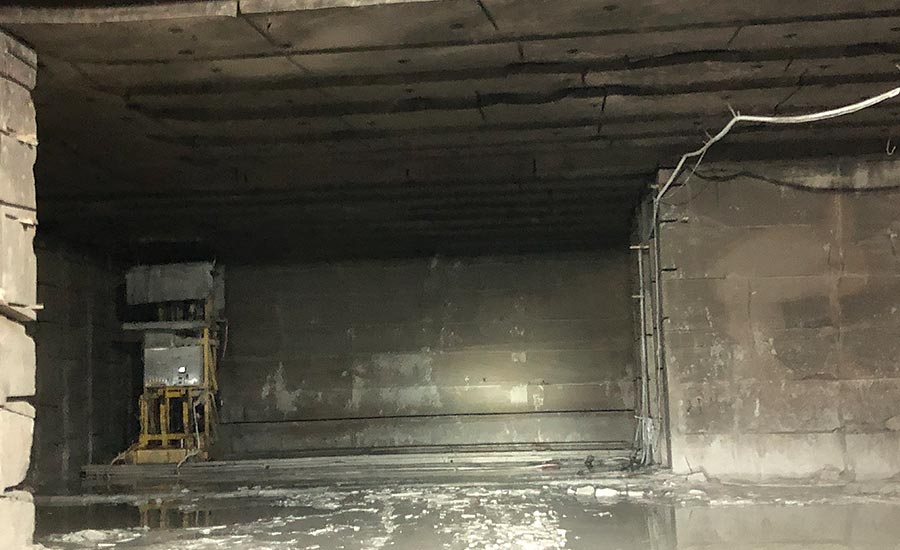
In 2015, Elliott Stone Company bought an existing stone shop and equipped it with a dust filtration system. “With all of the sustainable push, we thought it was a good idea,” he said. “We also recycle all of our water.”
Elliott Stone Company produces standardized products. It has five main distributors on the East Coast, who have 60 to 70 dealers under each of them. The company quarries 1 to 2 million feet annually and fabricates 300,000 to 500,000 cubic feet per year. According to Morgan, the New York/New Jersey area and upper New England is its biggest market for hardscape.
Indiana Limestone Company
In 2018, Indiana Limestone Company (ILCO) was merged by North American stone producer Polycor, who presently owns more than 50 quarries throughout the world, and the company has shown an increase in expansion over the past several years. YJ Zhang, director of quarry operations & materials at ILCO, explained that the company has 10 quarries – among them the historic Empire quarry, which is the site that produced the Indiana limestone for the Empire State Building in New York City – and in recent years is focusing its efforts on producing standard limestone products.
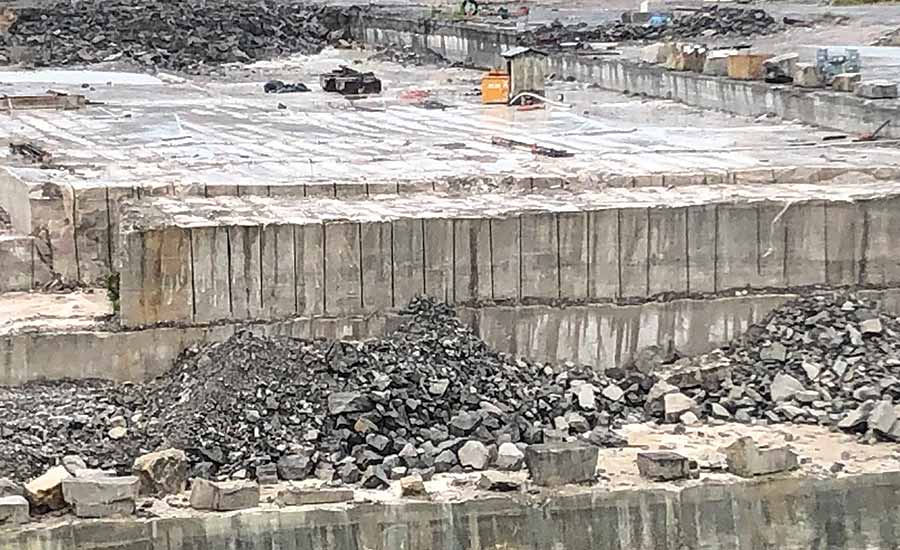
“In the last five years, we doubled our quarry production,” said Zhang. “The quarries produce about 2 million cubic feet a year.
“We are one of the largest quarriers within Polycor’s portfolio,” Zhang continued. “We produce 20,000 cubic feet per shift. Every year we plan and budget for where we will be quarrying and how much. We talk to our sales staff to see what the market is going to ask for.”
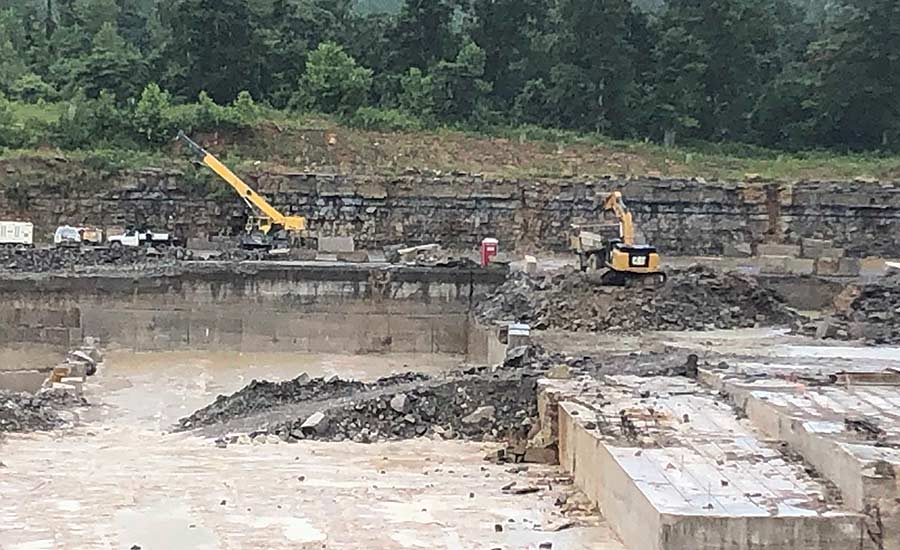
ILCO maintains approximately 100 workers in the quarry and a total of 200 in the company. A fleet of WF Meyers saws are used for quarry cutting and a set of heavy equipment are adopted to make the raw block. “Each block has a bar code with its grade, size, color and weight,” explained Zhang, adding that every day over 100 blocks are quarried.
Practicing environmentally friendly quarrying methods is important to ILCO. The company has completed certification of the NSC-373 standard, which indicates its commitment to sustainability.
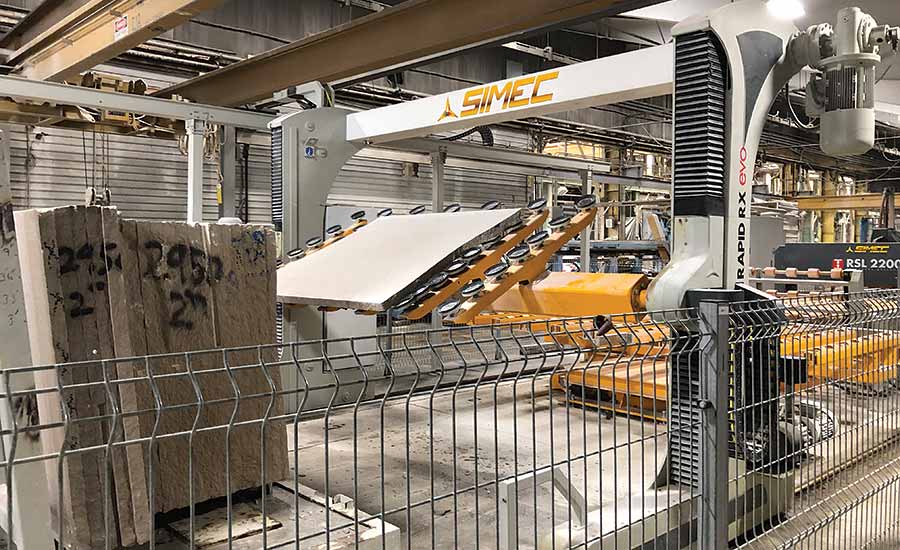
In late 2017, ILCO modernized its production process by investing in a Simec TLS 2200 RX production line, which was customized to the company’s need (pictured on bottom). “Our efficiency has improved three to one and it also has improved our quality,” said Zhang. “We started running the line in earlier 2018 and have continually been optimizing the process, and as a result, we are now saving on labor and it can be programmed for a specific type of piece or finish so all the pieces can be done on the same line.
Indiana Cut Stone
Established in 1997 by Don Baker, Indiana Cut Stone is run today by his children, Ernie and Kathy Baker-Heckard. On March 3, 2010, Indiana Cut Stone was certified as a Woman Business Enterprise (WBE) for the State of Indiana. WBE Certification denotes that a woman (or women) has majority ownership and control of a business entity. On November 16, 2015, Indiana Cut Stone was proud to earn its certification as a certified Women’s Business Enterprise (WBE) for the city of Indianapolis, IN. With this certification, the company is certified as a supplier/distributor trade specializing in: stone, limestone & natural rock products and related services. The certification was issued pursuant to the City of Indianapolis Minority & Women Business Utilization Plan, part B.
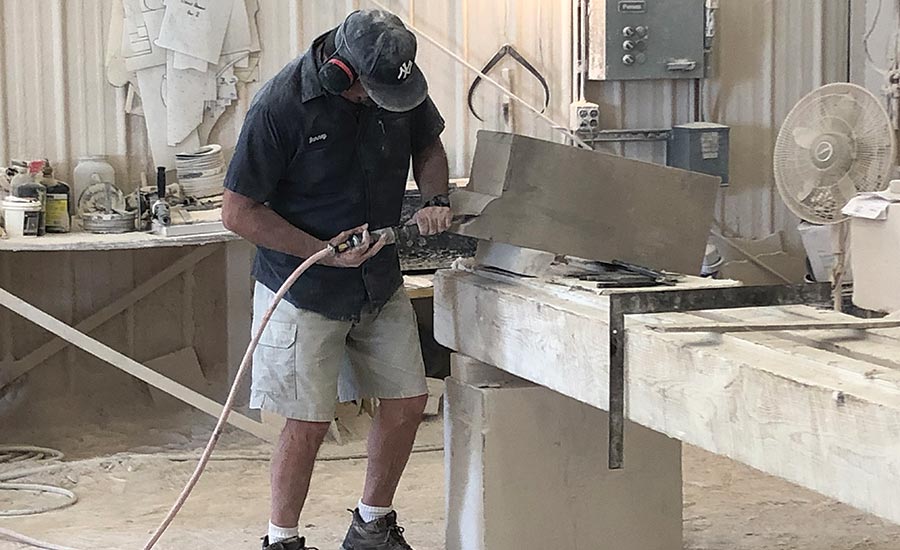
At this time, Indiana Cut Stone employs 17 workers, and handles a range of project types, including commercial, residential, governmental and custom work. “We also get the weird jobs no one else wants to do,” said Baker-Heckard. “Our production ebbs and flows with the economy, but the last five to six years have been good. Its feast or famine in this business.”
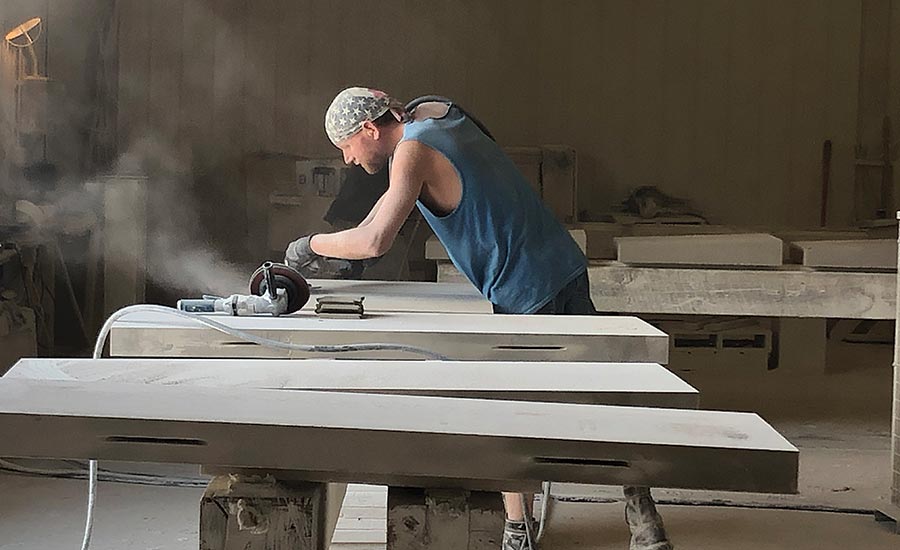
In the mill, there is a carver on staff, as well as two CNCs from Park Industries and one from Breton. “We do 40 to 50 projects at a time, which vary in size and difficulty,” said Baker-Heckard. “We fabricate for projects all over the country and have shipped in the past to England, Ireland and other countries.”
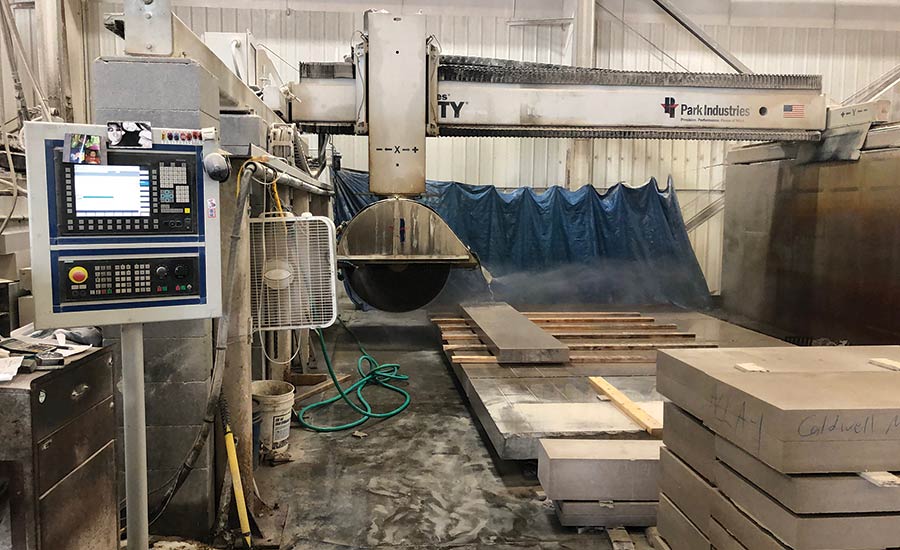
“Customer satisfaction is our number one goal and our entire team strives each day to make the order process of our products a simple and pleasant experience,” states the company. “From the smallest of projects to larger scale orders, we are confident that we will provide you with excellent service and the highest quality materials.”
B.G. Hoadley Quarries
The Maple Hill Quarry in Monroe County, which is leased by B.G. Hoadley Quarries, has been in operation since 1925 and under its current tenant since 1982. “We have been leasing from the same landlord since then,” said David Fell, president. “Maple Hill is infamous for what they call an ‘upset’ vein. It’s diagonal. It’s a blessing and a curse. Some people like ‘vanilla.’ This is for people who like a little character.”
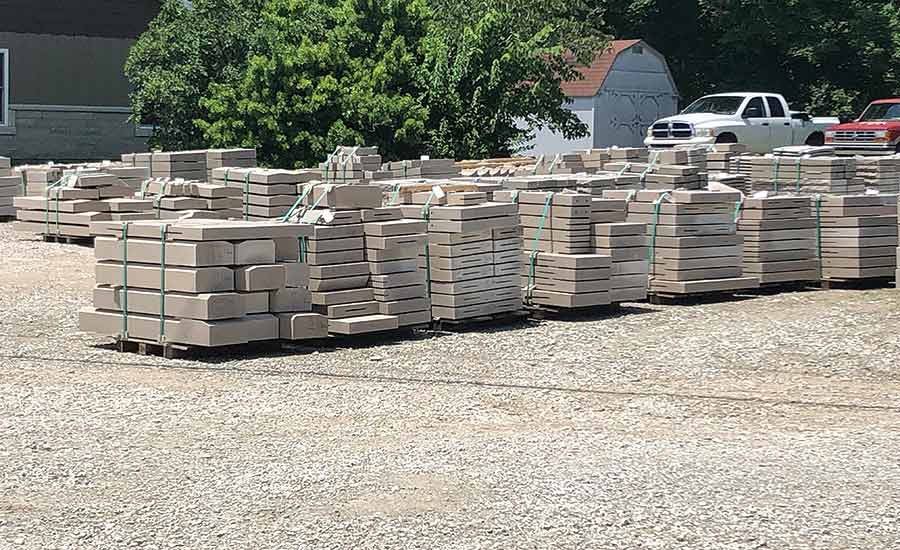
The site spans 65 acres, while there is 25 acres of deposit remaining. Approximately 70,000 cubic feet is quarried a month – depending on the recovery area. At the time of Stone World’s visit, the company was only quarrying the gray-colored variety of Indiana limestone. Machinery in the quarry includes WF Meyers saws, a Marini underwire saw and a Epiroc Girodrill.

According to Fell, the company’s main market is Ontario, Canada – reaching anywhere from Windsor to Ottawa – as well as the Great Lakes area in Wisconsin, Michigan and Minnesota. More recently, New Jersey has also become a market for Maple Hill, which primarily focuses on residential work.
Reed Quarries, Inc.
Now in its sixth generation, Reed Quarries, Inc. was started in 1870 when David Reed came over from Carlisle and Chester, England. David was the great-great grandfather of the company’s current owner, Steve Reed, who runs Reed Quarries with his wife, Debby, and son, Steve Reed Jr.
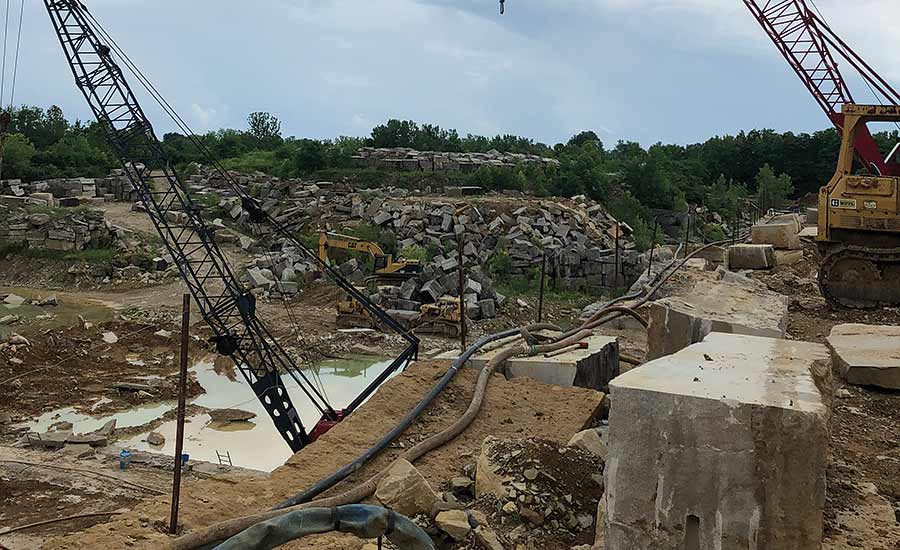
“At the start, Chicago’s city fathers recruited David Reed after the Great Fire, as they didn’t want to rebuild Chicago with wood,” said Debby Reed.
The quarry, which is in Bloomington, covers just over 100 acres and delves down 60 feet. “Because of the deposit, we stair-step down and quarry with cranes,” explained Steve Reed. “It has worked great for decades. Some floors aren’t good so we don’t waste time drilling down.”
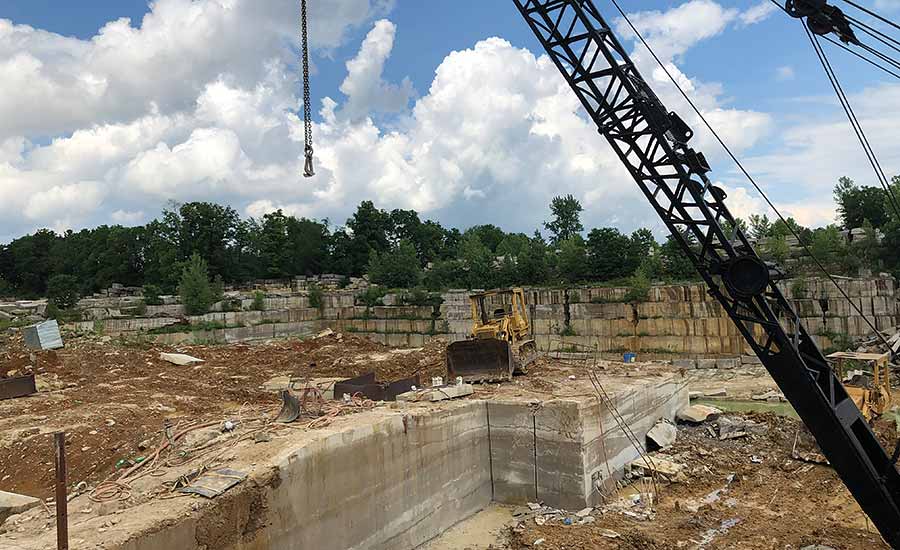
The site is quarried south to north, according to Debby Reed. “We are lucky this quarry produces predominantly Buff,” she said. “It’s really rewarding – a thrill of a lifetime.”
When discussing the quarrying methods, Debby Reed explained a great deal of planning goes into it. “It’s like a fine dance,” she said. “My husband, son and the foreman have to plan eight to 10 weeks out to keep things synchronized.”
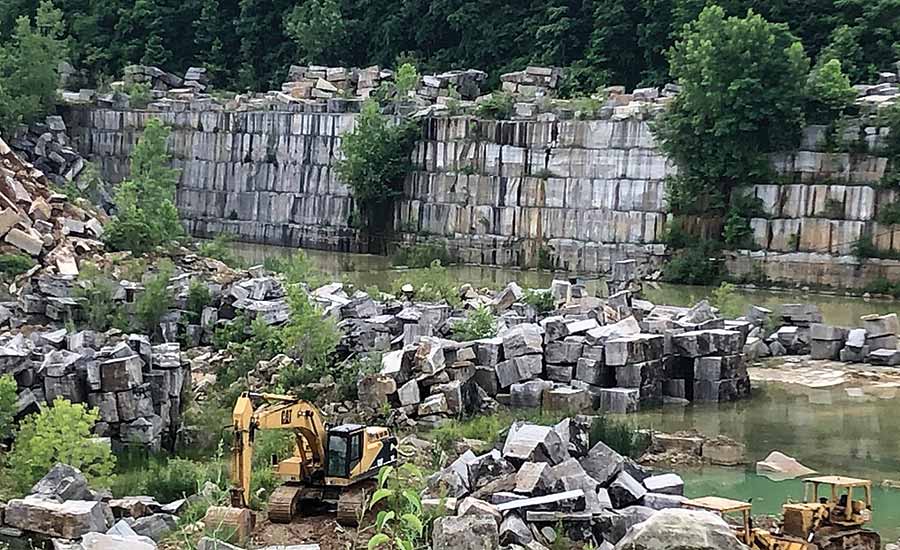
A portion of Reed Quarries’ customers buy blocks, which are shipped to Canada and all over the U.S. “We also work with other mills to cut slabs and project pieces,” said Debby Reed.







